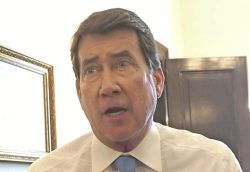Primary Balance: Prediction of Surplus Must Not Interfere with Fiscal Consolidation
17:15 JST, August 5, 2024
The government has issued estimates that a surplus will be achieved in the primary balances of the central and local governments in fiscal 2025. However, it is important not to be optimistic about these estimates, and to work steadily to pave the way for fiscal consolidation.
The primary balance is an indicator of how much government spending can be covered through tax revenues and other means, without relying on debt.
In 2002, the government set a goal of achieving a surplus in the primary balances, but it has never been realized. Estimates from January this year also indicated there would be a deficit of ¥1.1 trillion in fiscal 2025.
The government has now announced for the first time that the primary balances will see a surplus of ¥800 billion in fiscal 2025 because of higher tax revenues stemming from improved corporate earnings and higher prices. If realized, it would be the first surplus in 34 years.
However, even if estimates indicate a surplus, actually realizing one is not a simple thing. This is because the estimates do not take into account supplementary budgets to be compiled in the middle of the fiscal year.
The government drew up a large-scale supplementary budget of ¥73 trillion in fiscal 2020, when the country was hit by the COVID-19 pandemic. In fiscal 2021 and fiscal 2022, supplementary budgets at the ¥30 trillion level were earmarked.
Despite the government establishing a policy of “working to return the expenditure structure to normal” in June last year, the supplementary budget for fiscal 2023 ballooned to ¥13 trillion, and the path to fiscal reconstruction remains a long one. If large-scale supplementary budgets continue to be the norm, achieving a surplus in fiscal 2025 is quite unlikely.
Prime Minister Fumio Kishida intends to formulate economic measures this autumn that will include benefits for pensioner households, on the assumption that tax revenues will increase, but he must refrain from unbridled fiscal stimulus.
The balance between fiscal reconstruction and economic growth needs to be maintained. However, the fact that the estimates have turned for the better is largely attributed to an increase in the consumption tax, corporate tax and personal income tax revenues as a result of high prices that are straining household budgets. Therefore, one cannot be entirely pleased about the situation.
The request ceilings for fiscal 2025 budgets are almost the same as in the previous year, with no sign of the government’s commitment to paving the way for fiscal consolidation.
Ceilings serve as a guide when ministries and agencies make budgetary requests, but for important policies such as wage increases and measures to combat high prices, they can submit budget requests without specifying amounts. Given this, concerns exist that there could be no limit to the amount of money requested.
The outstanding balance of national debt, including government bonds, has climbed to about ¥1.3 quadrillion. This is more than double the nation’s GDP and the worst level among developed countries. Even if a primary balance surplus is achieved in fiscal 2025, it will only be a path marker in reducing the huge debt burden.
It has been pointed out that public concern about finances has caused people to cut back on their spending. The government and the ruling parties should set out a path to fiscal consolidation that is reassuring.
(From The Yomiuri Shimbun, Aug. 5, 2024)
"Editorial & Columns" POPULAR ARTICLE
-

Artificial Intelligence Expands Possibilities for Foreign Language Learners
-

Build Intellectual, Physical Strength, As Well As Communicative Power / Japan Should Move from Beneficiary to Shaper of World Order
-

Global Economy in Turmoil: Prevent Free Trade System from Going Adrift / Risks to Financial Markets Must Be Heeded
-

Japan-China Strain Set to Persist as Beijing Officials Self-Interestedly Bash Tokyo; Takaichi Unlikely to Back Down
-

Elderly People Living Alone: What Should be Done to Ensure Living with Peace of Mind until the End?
JN ACCESS RANKING
-

BOJ Gov. Ueda: Highly Likely Mechanism for Rising Wages, Prices Will Be Maintained
-

Japan Govt Adopts Measures to Curb Mega Solar Power Plant Projects Amid Environmental Concerns
-

Core Inflation in Tokyo Slows in December but Stays above BOJ Target
-

Major Japan Firms’ Average Winter Bonus Tops ¥1 Mil.
-

Bank of Japan Considered U.S. Tariffs, Coming Shunto Wage Hike Talks in Its Decision to Raise Interest Rates

























